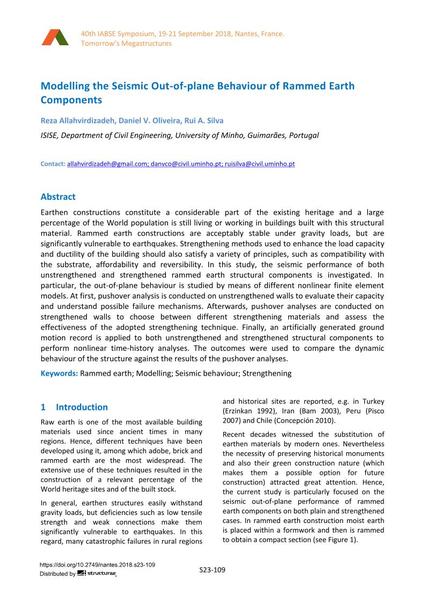Modelling the Seismic Out-of-plane Behaviour of Rammed Earth Components

|
|
|||||||||||
Bibliographic Details
| Author(s): |
Reza Allahvirdizadeh
(ISISE, Department of Civil Engineering, University of Minho, Guimarães, Portugal)
Daniel V. Oliveira (ISISE, Department of Civil Engineering, University of Minho, Guimarães, Portugal) Rui A. Silva (ISISE, Department of Civil Engineering, University of Minho, Guimarães, Portugal) |
||||
|---|---|---|---|---|---|
| Medium: | conference paper | ||||
| Language(s): | English | ||||
| Conference: | IABSE Symposium: Tomorrow’s Megastructures, Nantes, France, 19-21 September 2018 | ||||
| Published in: | IABSE Symposium Nantes 2018 | ||||
|
|||||
| Page(s): | S23-109 | ||||
| Total no. of pages: | 8 | ||||
| DOI: | 10.2749/nantes.2018.s23-109 | ||||
| Abstract: |
Earthen constructions constitute a considerable part of the existing heritage and a large percentage of the World population is still living or working in buildings built with this structural material. Rammed earth constructions are acceptably stable under gravity loads, but are significantly vulnerable to earthquakes. Strengthening methods used to enhance the load capacity and ductility of the building should also satisfy a variety of principles, such as compatibility with the substrate, affordability and reversibility. In this study, the seismic performance of both unstrengthened and strengthened rammed earth structural components is investigated. In particular, the out-of-plane behaviour is studied by means of different nonlinear finite element models. At first, pushover analysis is conducted on unstrengthened walls to evaluate their capacity and understand possible failure mechanisms. Afterwards, pushover analyses are conducted on strengthened walls to choose between different strengthening materials and assess the effectiveness of the adopted strengthening technique. Finally, an artificially generated ground motion record is applied to both unstrengthened and strengthened structural components to perform nonlinear time-history analyses. The outcomes were used to compare the dynamic behaviour of the structure against the results of the pushover analyses. |
||||
| Keywords: |
modelling seismic behaviour strengthening rammed earth
|
||||
